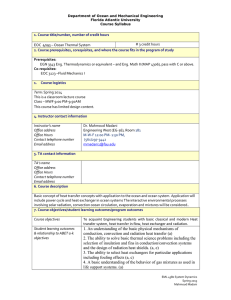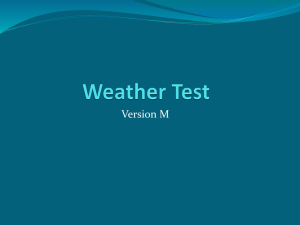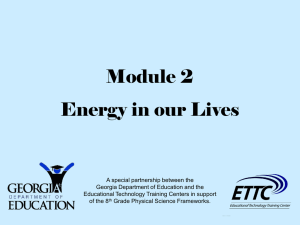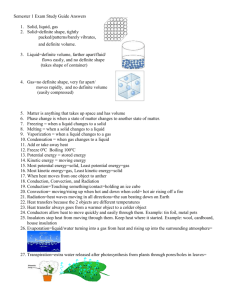Syllabus - Florida Atlantic University
advertisement
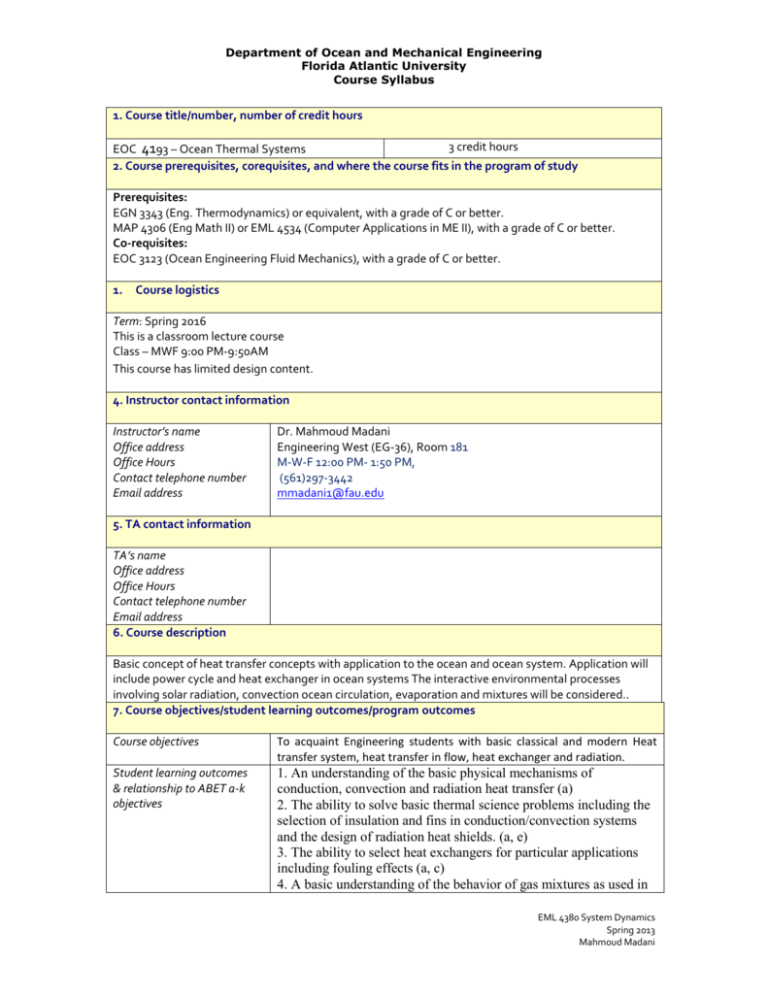
Department of Ocean and Mechanical Engineering Florida Atlantic University Course Syllabus 1. Course title/number, number of credit hours 3 credit hours EOC 4193 – Ocean Thermal Systems 2. Course prerequisites, corequisites, and where the course fits in the program of study Prerequisites: EGN 3343 (Eng. Thermodynamics) or equivalent, with a grade of C or better. MAP 4306 (Eng Math II) or EML 4534 (Computer Applications in ME II), with a grade of C or better. Co-requisites: EOC 3123 (Ocean Engineering Fluid Mechanics), with a grade of C or better. 1. Course logistics Term: Spring 2016 This is a classroom lecture course Class – MWF 9:00 PM-9:50AM This course has limited design content. 4. Instructor contact information Instructor’s name Office address Office Hours Contact telephone number Email address Dr. Mahmoud Madani Engineering West (EG-36), Room 181 M-W-F 12:00 PM- 1:50 PM, (561)297-3442 mmadani1@fau.edu 5. TA contact information TA’s name Office address Office Hours Contact telephone number Email address 6. Course description Basic concept of heat transfer concepts with application to the ocean and ocean system. Application will include power cycle and heat exchanger in ocean systems The interactive environmental processes involving solar radiation, convection ocean circulation, evaporation and mixtures will be considered.. 7. Course objectives/student learning outcomes/program outcomes Course objectives To acquaint Engineering students with basic classical and modern Heat transfer system, heat transfer in flow, heat exchanger and radiation. Student learning outcomes & relationship to ABET a-k objectives 1. An understanding of the basic physical mechanisms of conduction, convection and radiation heat transfer (a) 2. The ability to solve basic thermal science problems including the selection of insulation and fins in conduction/convection systems and the design of radiation heat shields. (a, e) 3. The ability to select heat exchangers for particular applications including fouling effects (a, c) 4. A basic understanding of the behavior of gas mixtures as used in EML 4380 System Dynamics Spring 2013 Mahmoud Madani Department of Ocean and Mechanical Engineering Florida Atlantic University Course Syllabus life support systems. (a) 5. The ability to select appropriate prime mover systems for marine systems. (k) 8. Course evaluation method Homework – 10% Project – 20% Midterm Exam – 30% Final Examination – 40% 9. Course grading scale Note: The minimum grade required to pass the course is C. Grading Scale: 95 and above: “A”, 90-94: “A-“, 85-89: “B+”, 80-84: “B”, 75-79 : “B-“, 70-74: “C+”, 65-69: “C”, 60-64: “C-“, 50-59: “D+”, 50 and below: “F.” 10. Policy on makeup tests, late work, and incompletes Extra work or Problems at class help student to gain their deficiency in the tests and exams. Therefore, no makeup exam needed. 11. Special course requirements . 12. Classroom etiquette policy University policy requires that in order to enhance and maintain a productive atmosphere for education, personal communication devices, such as cellular phones and laptops, are to be disabled in class sessions. 13. Disability policy statement In compliance with the Americans with Disabilities Act (ADA), students who require special accommodations due to a disability to properly execute coursework must register with the Office for Students with Disabilities (OSD) located in Boca Raton campus, SU 133 (561) 297-3880 and follow all OSD procedures. 14. Honor code policy Students at Florida Atlantic University are expected to maintain the highest ethical standards. Academic dishonesty is considered a serious breach of these ethical standards, because it interferes with the university mission to provide a high quality education in which no student enjoys unfair advantage over any other. Academic dishonesty is also destructive of the university community, which is grounded in a system of mutual trust and place high value on personal integrity and individual responsibility. Harsh penalties are associated with academic dishonesty. See University Regulation 4.001 at www.fau.edu/regulations/chapter4/4.001_Code_of_Academic_Integrity.pdf 15. Required texts/reading EML 4380 System Dynamics Spring 2013 Mahmoud Madani Department of Ocean and Mechanical Engineering Florida Atlantic University Course Syllabus Textbook: Heat and Mass transfer Fundamental and application, 4th Edition by; Yunus A. Cengel and Afshin J. Ghajar, McGraw-Hill, 2010. 16. Supplementary/recommended readings 17. Course topical outline, including dates for exams/quizzes, papers, completion of reading Course Topics: 1. 2. 3. 4. 5. 6. 7. 8. 9. 10. 11. Introduction: Heat Transfer, Conduction, Convection, Radiation (3 Hours) One dimension steady state heat transfer, Heat resistance and capacitance, Heat transfer in two dimension, spherical and cylindrical form of heat transfer(4 Hours) Steady Heat Conduction in Plane Walls, Thermal Contact Resistance, Generalized Thermal Resistance Networks, Heat Conduction in Cylinders and Spheres, Critical Radius of Insulation, Transfer from Finned Surfaces, Fin Efficiency, Fin Effectiveness, Heat Transfer in Common Configurations (6 Hours) Lumped System Analysis, Criteria for Lumped System Analysis, Some Remarks on Heat Transfer in Lumped Systems, Transient Heat Conduction in Large Plane Walls, Long Cylinders, and Spheres with Spatial Effects, Nondimensionalized One-Dimensional Transient Conduction Problem, Exact Solution of One-Dimensional Transient Conduction Problem, Transient Heat Conduction in Semi-Infinite Solids, Contact of Two Semi-Infinite Solids, Transient Heat Conduction in Multidimensional Systems (5 Hours) Physical Mechanism of Convection, Nusselt Number, Classification of Fluid Flows, Velocity Boundary Layer, Wall shear stress, Thermal Boundary Layer, Prandtl Number, Laminar and Turbulent Flows, Reynolds Number, Heat and Momentum Transfer in Turbulent Flow, Derivation of Differential Convection Equations, Solutions of Convection Equations for a Flat Plate, Functional Forms of Friction and Convection Coefficients (6 Hours) Drag and Heat Transfer in External Flow, Friction and pressure drag, Heat transfer, Parallel Flow Over Flat Plates, Friction coefficient, Heat transfer coefficient, Flat plate with unheated starting length, Uniform Heat Flux, Flow Across Cylinders and Spheres, Effect of surface roughness, Heat transfer coefficient, Flow across Tube Banks, Pressure drop (6 Hours) Average Velocity and Temperature, Laminar and turbulent Flow in tubes, General Thermal Analysis, Constant Surface Heat Flux, Constant Surface Temperature, Laminar flow in tubes Turbulent flow in tubes (5 Hours) Types of Heat Exchangers, The Overall Heat Transfer Coefficient, Fouling factor, Analysis of, Heat Exchangers, The Log Mean Temperature Difference Method, Counter-Flow Heat, exchangers, Multipass and Cross-Flow Heat Exchangers: Use of a, Correction Factor, The Effectiveness–NTU Method, Selection of Heat Exchangers, (5 Hours) The View Factor, View Factor Relations, Radiation Heat Transfer: Black Surfaces, Radiation Heat Transfer: Diffuse, Gray Surfaces, Radiosity, Net Radiation Heat Transfer to or from a Surface, Radiation Exchange with Emitting and Absorbing Gases, Radiation Properties of a Participating Medium, Emissivity and Absorptivity (7 hours) Gas mixture used in heat transfer. (2 hours) EML 4380 System Dynamics Spring 2013 Mahmoud Madani
